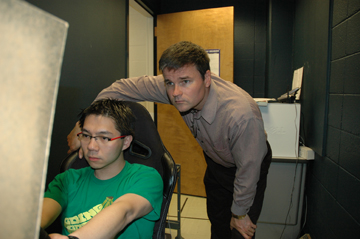Professor sheds light on prevalence of texting and driving
It’s no secret that sending text messages while behind the wheel is dangerous. In fact, studies show a texting motorist is four to six times more likely to be involved in an accident than someone who is drunk.
A new study from Paul Atchley, associate professor of psychology at the University of Kansas, sheds alarming new light on just how prevalent texting while driving is among the age group most likely to engage inn the behavior.

“There’s a lot of data showing it’s dangerous, but people have wanted to believe that it’s not all that common,” Atchley said. “I think this study shows it’s far more common and it’s going to become far more common in the future.”
Atchley led a recent survey of 400 college students aged 18 to 30 on their texting and driving habits. The study, funded in part through KU’s Transportation Research Institute, split texting into three categories: initiating, replying and reading. The results showed 95 percent of the students were likely to initiate or respond to a text message while driving, factoring in those who said they engaged in the behavior while stopped in traffic.
The survey shows 70 percent of college-aged drivers said they initiate texts, 81 percent reply to texts and 92 percent read texts. Additional small percentages of those surveyed said they texted only while stopped in traffic.
Atchley’s research team examined the circumstances surrounding what would likely trigger a motorist to initiate or respond to a text. Status updates and instant gratification ranked as the two most likely reasons to initiate a text while behind the wheel.
The survey also showed the students recognized the inherent dangers of texting behind the wheel — rating it far more risky than talking on a cell phone. More surprising though, Atchley said, was the mindset behind students rationalizing a behavior they knew to be risky.
“People know this is a risky behavior, but they do it, so now they’re faced with a dilemma knowing that they’re involved in something risky,” Atchley said. “So you can say to yourself, ‘Maybe it’s not as risky as everyone makes it out to be.’ We found if someone makes the choice to engage in the behavior, they perceive it as being less risky.”
Atchley said it’s the same rationale often adopted by those addicted to nicotine.
“If you’re a smoker and you choose to continue to smoke, then you say to yourself, ‘Well, this isn’t as risky as everyone makes it out to be.’ ”
The data showed that drivers are aware of the risk of texting and it reduces the likelihood of initiating a text, but it is a small effect. The stronger effect seems to be that initiating a text changes the perception of risk. Atchley said college-age drivers represent the future of road safety and their practices now will become habits later. Other studies have shown that the college-age group develops a strong sense of belonging through social networks — and texting is rapidly becoming the leading form of communication for this group.
“They will become safer drivers over time, but texting will still be how they communicate,” Atchley said. “But even if texting and driving gets cut in half, that’s still almost half of all drivers that do it.”
The survey is under consideration to be published in “Accident Analysis and Prevention,” a leading transportation journal.